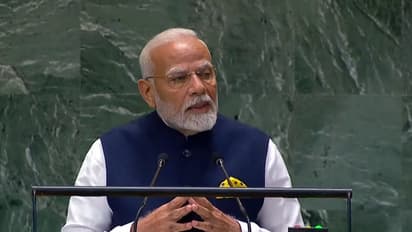PM Modi launches indigenous PARAM Rudra supercomputers for India's tech future

Synopsis
In Delhi, the Inter-University Accelerator Centre (IUAC) will use the advanced computing capabilities of PARAM Rudra for research in material science and atomic physics. The enhanced computing power will allow scientists to delve deeper into atomic interactions and properties, driving advancements in various applications.
In a major step towards strengthening India's scientific and technological landscape, Prime Minister Narendra Modi on Thursday (September 26) virtually launched three indigenously developed PARAM Rudra supercomputers. This development comes in part of India's National Supercomputing Mission (NSM), which aims to advance research and innovation through high-performance computing (HPC).
The supercomputers, installed in Pune, Delhi, and Kolkata, were developed at a cost of Rs 130 crore. Their primary purpose is to provide cutting-edge research across various scientific fields, ranging from astronomy to material science and cosmology. Highlighting the transformative role of technology, PM Modi said, "There is no sector which does not rely on technology and computing capability. In this revolution, our share should not be in bits and bytes but in terabytes and petabytes."
Karnataka withdraws general consent to CBI as BJP demands probe in MUDA land scam case
Each of the PARAM Rudra systems has been strategically deployed to serve specific research needs. In Pune, the Giant Metre Radio Telescope (GMRT) will harness the new supercomputing power to study astronomical phenomena like Fast Radio Bursts (FRBs). This could potentially lead to groundbreaking discoveries in the field of astrophysics.
In Delhi, the Inter-University Accelerator Centre (IUAC) will use the advanced computing capabilities of PARAM Rudra for research in material science and atomic physics. The enhanced computing power will allow scientists to delve deeper into atomic interactions and properties, driving advancements in various applications.
Similarly, the SN Bose National Centre for Basic Sciences in Kolkata will focus on physics, cosmology, and earth sciences. By leveraging the PARAM Rudra system, the institute aims to accelerate its research in these domains, particularly in understanding complex cosmological phenomena.
The Prime Minister noted that the deployment of these supercomputers underlines India's growing self-reliance in high-performance computing. "With PARAM Rudra Supercomputers, India takes a significant step towards self-reliance in computing and driving innovation in science and technology," the Prime Minister said in a post on X.
Shiv Sena's Sanjay Raut granted bail after 15-day jail term in defamation case
The National Supercomputing Mission (NSM), a joint initiative of the Ministry of Electronics and Information Technology (MeitY) and the Department of Science and Technology (DST), has been instrumental in advancing India's HPC capabilities. The mission aims to establish a network of advanced computing systems across the country, fostering research and development in critical sectors.
Although PM Modi had planned to visit Pune for the event, heavy rains in the city led to a virtual launch. Along with the supercomputers, PM Modi was scheduled to inaugurate a Metro train line and launch several development projects worth Rs 22,600 crore.
Stay updated with the Breaking News Today and Latest News from across India and around the world. Get real-time updates, in-depth analysis, and comprehensive coverage of India News, World News, Indian Defence News, Kerala News, and Karnataka News. From politics to current affairs, follow every major story as it unfolds. Get real-time updates from IMD on major cities weather forecasts, including Rain alerts, Cyclone warnings, and temperature trends. Download the Asianet News Official App from the Android Play Store and iPhone App Store for accurate and timely news updates anytime, anywhere.